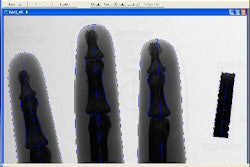VIENNA - MR angiography does a good job of visualizing stenosis of the coronary arteries, according to Japanese researchers who presented their findings on Monday at the European Congress of Radiology (ECR).
Getting good images of the coronary arteries has always been one of the toughest tasks in cardiac MRI, due to the small size of the vessels and the artifact-inducing effect of cardiac and respiratory motion. But recent advances in MRI technology, such as parallel-imaging techniques, are making the task easier.
Whole-heart coronary artery imaging with MRI, using a free-breathing 3D steady-state free precession technique, has already demonstrated the technical capability to visualize all the coronary segments and is a less invasive alternative to conventional x-ray coronary angiography. But the technique has not yet been proven in a large number of patients, according to Dr. Hajime Sakuma of Mie University in Mie, Japan.
The group set out to demonstrate MR angiography's capability in the coronaries by examining 92 patients using a 1.5-tesla MRI scanner optimized for cardiac studies (Gyroscan Intera, Philips Medical Systems, Andover, MA). The group performed conventional coronary angiography within two weeks of MRA.
The group first conducted a survey MRI scan, a reference scan for the SENSE technique, a short axial cine MRI to determine right coronary artery motion and the diastolic rest period, and then the whole-heart coronary MRA, Sakuma said. All scans were performed during free breathing.
The MRA acquisition used a 3D balanced TFE ultrafast gradient-echo technique with radial k-space sampling, navigator echo, SPIR for fat saturation, and T2 prep for suppressing myocardial signal. Other scanning parameters were as follows: TR = 4.6 msec, TE = 2.3 msec, 280 x 280 x 120 field-of-view, and a parallel imaging SENSE factor of 2 to reduce the total imaging time.
The group obtained successful MRA acquisition within 30 minutes in 78/92 patients, or 84.8%. Diagnostic images of all coronary artery segments were achieved in 75/92 patients, or 81.5%. The average imaging time was 13.3 minutes, and if the total acquisition time exceeded 30 minutes, the researchers discontinued the study, Sakuma said.
Analyzing the data by coronary segments visualized, MRA produced the following results:
-
Sensitivity: 87%
Specificity: 96%
Positive predictive value: 80%
Negative predictive value: 98%
Overall accuracy: 95%
Analyzing the data on a per-patient basis, the technique produced the following results:
Sensitivity: 85%
Specificity: 90%
Positive predictive value: 88%
Negative predictive value: 88%
Overall accuracy: 88%
"Whole-heart coronary MRA with a navigator-gated steady-state sequence can provide noninvasive detection of coronary artery stenosis with a reasonably high diagnostic accuracy," Sakuma said.
During the question-and-answer session following the presentation, Sakuma explained that irregular patient breathing was the most common factor complicating the success rate for the procedure. If breathing caused the patient's diaphragm to move to another level, the study would have to be repeated, he said.
Another question regarded the use of MRI scanners with higher radiofrequency channel counts than the machine that Sakuma's group used. If they had their choice, would they pick higher spatial resolution or a faster exam time? Sakuma said he would pick faster exam times, which would enable coronary imaging in a breath-hold, improving the success rate of the procedure.
"If we use a SENSE factor of 3 or 4, then the average imaging time would be two to three minutes, and the success rate will be much improved," Sakuma said.
Sakuma closed his presentation by saying that while he was encouraged by the high negative predictive value of the study, he would like to see the 85% success rate of the procedure improved.
By Brian Casey
AuntMinnie.com staff writer
March 7, 2005
Related Reading
For now, MRI edges CT in coronary angio race, December 20, 2004
CT and MRI taking over x-ray's volume, report says, November 16, 2004
Coronary stents: Safe with MRI, evaluable with CTA, November 10, 2004
Is MRI the new gold standard for assessing myocardial viability? November 9, 2004
Preliminary results of MRI angiography show reliability in detecting CAD, April 7, 2003
Copyright © 2005 AuntMinnie.com



















